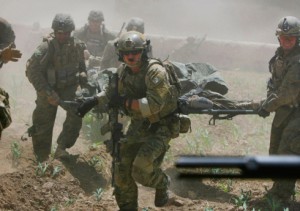
Pararescuemen walk line between fierce warrior, caring savior
Laura Rauch
Stars and Stripes, 29 October 2012
While their core function is combat rescue and the personnel recovery of downed aircraft, Air Force pararescue teams also fly throughout Afghanistan augmenting the Army medevac mission.
Though medevac and pararescue overlap in terms of pulling the wounded from the battlefield, they are distinctively different. While medevac adheres to the Geneva Conventions by flying in unarmed helicopters marked with red crosses, pararescue flies in unmarked birds equipped with two .50 caliber machine guns. And they carry the guardian angels.

“We are a weapons system, we are armed,” Senior Airman and Pararescueman Jason Sweet said. “We’re shooters, divers, jumpers, technical rescue specialists. We’re ready to rescue anyone, anywhere, anytime.”
While the inception of Air Force combat rescue began in 1947, its legacy has been forged in every conflict since Korea.
The helicopters fly in pairs, one designated as the trail aircraft, and one as lead. Each is capable of landing in the hot zone or providing covering fire from above.
Phi Beta Iota: Peace Jumpers capable of calling in precision parachute drops are a variation of this idea. They too would have guardian angels, but the focus would be on protection from proven rapid delivery of what is needed on the ground in the moment.



